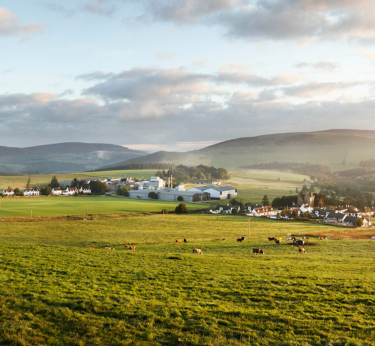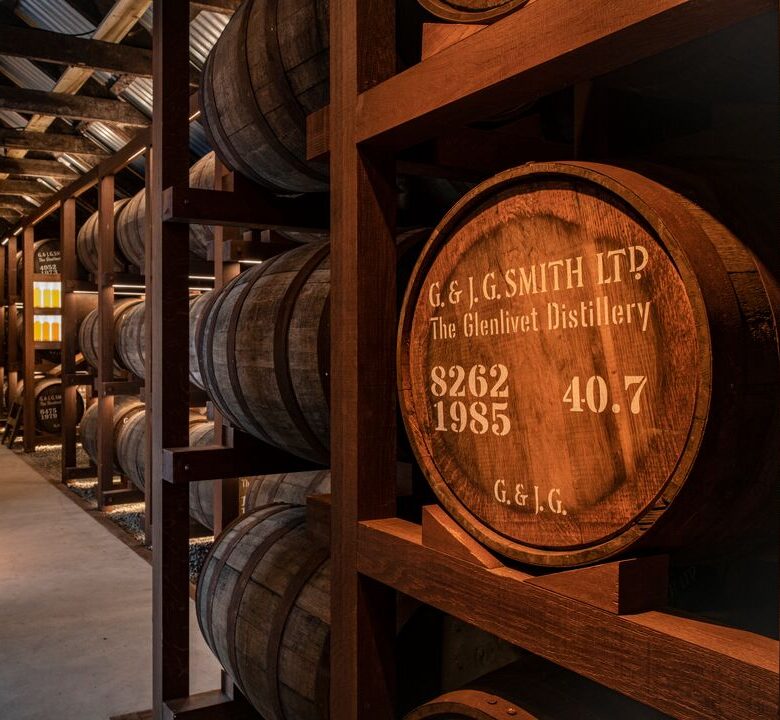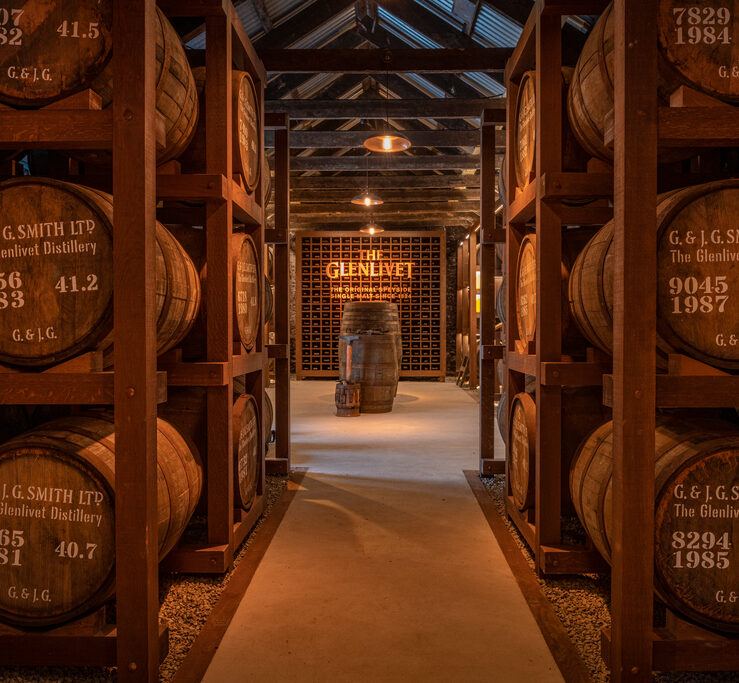
There are five whisky regions of Scotland: Islay, Campbeltown, Highlands, Lowlands and Speyside. These locations are known the world over for their scotch production with expressions that capture the essence of the local landscapes.
Speyside has the highest number of distilleries in Scotland and whisky has long been the lifeblood of the region. It was in this area, hidden within the Livet Valley, that our founder George Smith first learned his craft and began making a smooth scotch whisky that would still be highly renowned across the globe over 200 years later.
Let’s take a journey to this part of Scotland and explore the home of Speyside whisky in more detail with this whisky guide.
Where is Speyside?
Speyside is in the northeastern part of Scotland. It is situated within the Highlands, which is the largest whisky region in Scotland but is recognised in its own right. It’s the most densely populated whisky region in the world and is known for its concentration of distilleries along the river Spey, hence the name “Speyside”.
The region encompasses areas such as Moray, Banffshire, and parts of Aberdeenshire. The Glenlivet distillery is located between Ballindalloch and Tomnavoulin, right on the edge of Cairngorms National Park.
There are plenty of things to do in Speyside including walking the coast trails where you can take in stunning sea views, rounds of golf on pristine greens, and of course, a trip to The Glenlivet Distillery.
What makes Speyside different from other whisky regions?
Speyside is distinct from other whisky-producing regions for several reasons. Firstly, as has already been mentioned, Speyside boasts the highest number of distilleries of any whisky-producing region in Scotland. This concentration fosters a rich tradition of whisky-making and allows for a diverse range of styles and flavours. Speyside distilleries often blend traditional whisky-making practices with innovative techniques, resulting in a dynamic range of whiskies that appeal to both traditionalists and those seeking new flavour experiences.
Speyside is also blessed with an abundance of natural resources crucial for whisky production, including pure spring water, and locally grown barley, which influences the flavour profile of the whiskies produced here. The Glenlivet distillery uses malted barley from Portgordon and sources its water from nearby springs, including Josie’s Well.
What’s more, the microclimate in Speyside is unique, characterised by mild temperatures and a relatively dry climate. This contributes to the maturation process of whisky, allowing for a smooth and balanced end product.
How is scotch made in Speyside?
Scotch production in Speyside follows the time-honoured Scottish methods used throughout the country. Barley is the primary grain used when it comes to how scotch is made in the region, and some distilleries still practise floor malting.
Once the barley is malted, it’s ground into a grist and mixed with hot water in a large vessel called a mash tun. Speyside distilleries typically use mineral water sourced from local springs or the river Spey itself, known for its purity and softness. After fermentation, the resultant wash is distilled. Many whisky producers, including The Glenlivet, use traditional copper pot stills to do this.
As with all scotches, Speyside varieties must be matured for a minimum of three years in oak casks. In the region, whiskies are commonly aged in ex-sherry casks which impart notes of dried fruits, spices and nuts.
What is special about Speyside whisky?
If comparing whisky types around the world, Speyside whiskies are celebrated for their elegant yet complex flavours, based on fruity, floral, and nutty notes. Some of the key features that make Speyside whisky special include:
Rich diversity
Being home to a wide variety of distilleries, each with its own unique style and flavour profile, Speyside whiskies cater to a broad range of tastes, with expressions ranging from light and delicate to rich and robust.
Smoothness and balance
Many Speyside whiskies are renowned for their smooth, well-balanced character, making them highly approachable for both novice and seasoned whisky enthusiasts.t.
Age-worthy expressions
Speyside distilleries produce a range of aged expressions, including single malts and blends, that often exhibit exceptional complexity and depth as they mature in oak casks. Speyside whiskies are known for their frequent use of sherry casks in the maturation process, imparting rich, fruity flavours and a distinctive depth to the whisky.
Cultural significance
Speyside has a rich whisky-making heritage dating back centuries, and many of its distilleries are steeped in tradition and craftsmanship, contributing to the region’s cultural significance within the world of whisky.
These factors combine to make Speyside whisky a cherished and revered category within the world of Scotch whisky, prized for its quality, complexity, and rich heritage. They also set Speyside whisky apart from those produced in the other whisky regions. For example, there is a difference between Highland and Speyside whisky even though the latter lies within the former. Highland whiskies do exhibit a broad spectrum of flavours due to the region’s size, however, they tend to be peatier and smokier than Speyside varieties.
Our Speyside whiskies
As one of the oldest producers in Speyside and the first legal distillery in the parish of Glenlivet, The Glenlivet has had more than two centuries to hone its scotch production and craft sophisticated single malts. It’s near impossible to pick The Glenlivet’s best Speyside whiskies so instead, here’s a showcase of some of our most popular expressions through to our rare whisky varieties:
The Glenlivet Founder’s Reserve
We can’t talk about Speyside whiskies without mentioning The Glenlivet’s Founder’s Reserve smooth scotch whisky. It’s a tribute to the man who started it all, George Smith, and is made from the same crystal-clear waters that were used when the distillery was first established. It’s matured in traditional oak and American first-fill casks, resulting in a creamy sweetness with notes of citrus fruits.
The Glenlivet 12-Year-Old Illicit Still
Inspired by how our Speyside whisky was produced in the 1800s, The Glenlivet’s 12-year-old illicit still single malt scotch is non-chill filtered for an authentic taste reminiscent of George Smith’s very first batches which were handcrafted illegally in smaller copper stills.
The Glenlivet 16 1st Fill Sherry Butt
As is quite common for Speyside whiskies, The Glenlivet 16-year-old single-cask scotch is aged in European sherry butts. As a result, it boasts a deep, fruity profile with hints of liquorice and ginger.
The Glenlivet Winchester Collection 1967
Steeped in Speyside history, only 150 bottles of this 50-year-old scotch exist in the world. Crafted from a rare cask set aside by former Master Distiller, Robert Arthur, this expression has a rich aroma woven with apricots, peaches and toasted almonds, and a flavour that combines fondant orange and smooth milk chocolate.
Without a doubt, Speyside shares something special with the whisky that is produced here. The rolling hills and salmon-rich rivers have created an environment that lends itself to crafting truly great scotch. But geography is just one factor that influences a dram. To learn more about the intricacies of whisky production, check out our guides on cask strength and chill-filtered whisky.



